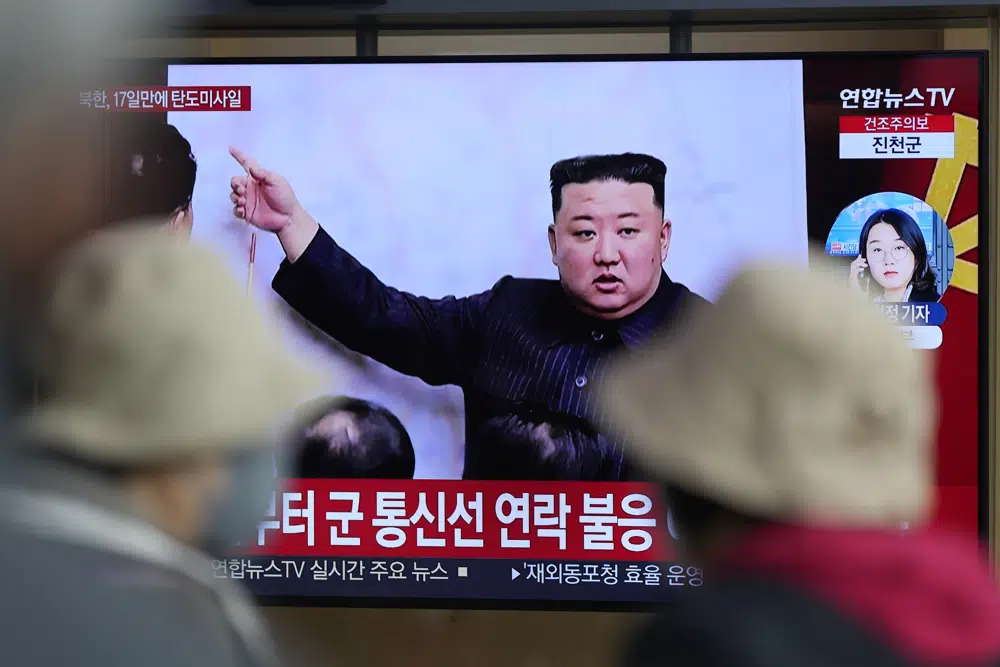North Korea said Friday it has successfully test-launched a new intercontinental ballistic missile powered by solid propellants, a development that if confirmed could possibly provide the country with a harder-to-detect weapon targeting the continental United States.
North Korea’s official Korean Central News Agency issued the report a day after its neighbors detected the launch from an area near its capital of Pyongyang, which added to a spate of testing that so far involved more than 100 missiles fired into sea since the start of 2022.
KCNA said the test was supervised on site by North Korean leader Kim Jong Un, who described the missile — named Hwasong-18 — as the most powerful weapon of his nuclear forces that would enhance counterattack abilities in the face of external threats created by the military activities of the United States and its regional allies.
Kim pledged to further expand his nuclear arsenal so that his rivals “suffer from extreme anxiety and fear while facing an insurmountable threat, and be plunged into regrets and despair over their decisions.”
North Korea has justified its weapons demonstrations as a response to the expanding military exercises between the United States and South Korea, which the North condemns as invasion rehearsals while using them as a pretext to push further its own weapons development.
“Respected comrade Kim Jong Un said speeding up the development of evolving and more advanced and powerful weapons systems is our party and government’s consistent policy to respond to military threats and worsening security situation on the Korean Peninsula,” KCNA said.
It cited Kim as saying that the Hwasong-18 would rapidly advance North Korea’s nuclear response posture and further support an aggressive military strategy that vows to maintain “nuke for nuke and an all-out confrontation for an all-out confrontation” against its rivals.
“The Hwasong-18 weapons system to be run by the country’s strategic forces would play its mission and role to defend (North Korea), deter invasions and preserve the country’s safety as its most powerful method,” KCNA said.
North Korea has tested various intercontinental ballistic missiles since 2017 that demonstrated potential range to reach the U.S. mainland, but its previous missiles were powered by liquid-fuel engines that need to be fueled relatively shortly before launch, as they cannot remain fueled for prolonged periods.
An ICBM with built-in solid propellants would be easier to move and hide and could be fired more quickly, reducing the opportunities for opponents to detect and counter the launch. But it wasn’t immediately clear from Friday’s report how close the North has come to acquiring a functional solid-fuel ICBM that would be capable of reaching and striking the U.S. mainland.
South Korea’s Defense Ministry maintains that North Korea hasn’t acquired a reentry vehicle technology needed to protect warheads for ICBMs from the harsh conditions of atmospheric reentry. Last month, South Korean Defense Minister Lee Jong-Sup also told lawmakers that North Korea hasn’t likely yet mastered the technology to place nuclear warheads on its most advanced short-range missiles targeting South Korea, though he acknowledged the country was making considerable progress on it.
“This is a significant breakthrough for the North Koreans, but not an unexpected one,” Ankit Panda, an expert with the Carnegie Endowment for International Peace, said.
“The primary significance of solid-fuel ICBMs is in terms of what they’ll do for the survivability of North Korea’s overall ICBM force,” he said.
“Because these missiles are fueled at the time of manufacture and are thus ready to use as needed, they will be much more rapidly useable in a crisis or conflict, depriving South Korea and the United States of valuable time that could be useful to preemptively hunt and destroy such missiles.”
KCNA described the Hwasong-18 as a three-stage missile but it wasn’t immediately clear whether the third stage was activated during the test. During the test, the missile’s first stage was set to a mode that would support a standard ballistic trajectory but the second and third stages were programmed to fly on higher angles after separations to avoid the territories of neighbors, KCNA said.
The agency said the test didn’t threaten the security of other countries as the first and second stages fell into waters off the country’s eastern coast but it provided no details about how the test affected the third stage.
Solid-fuel ICBMs highlighted an extensive wish list Kim announced under a five-year arms development plan in 2021, which also included tactical nuclear weapons, hypersonic missiles, nuclear-powered submarines and spy satellites.
The North has fired around 30 missiles this year alone over 12 different launch events as both the pace of its weapons development and the U.S.-South Korean military exercises increase in a cycle of tit-for-tat.
The U.S. and South Korean militaries conducted their biggest field exercises in years last month and separately held joint naval and air force drills involving a U.S. aircraft carrier strike group and nuclear-capable U.S. bombers.
North Korea claimed the drills simulated an all-out war against North Korea and communicated threats to occupy Pyongyang and decapitate its leadership. The United States and South Korea have described their exercises as defensive in nature and said that the expansion of those drills is necessary to cope with the North’s evolving threats.
Experts say Kim’s nuclear push is aimed at eventually forcing the United States to accept the idea of the North as a nuclear power and negotiating economic and security concessions from a position of strength.
Nuclear negotiations between Washington and Pyongyang have stalled since 2019 over disagreements in exchanging the release of crippling U.S.-led sanctions against the North and the North’s steps to wind down its nuclear and missile program.
(AP)











